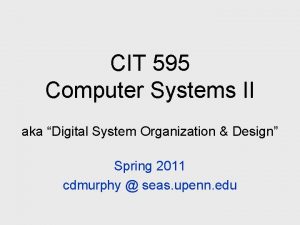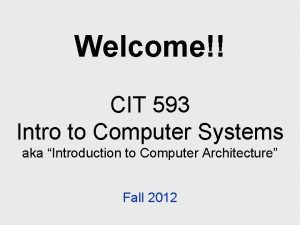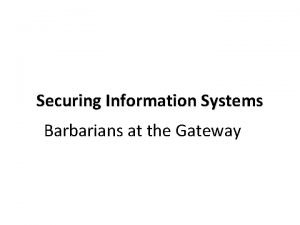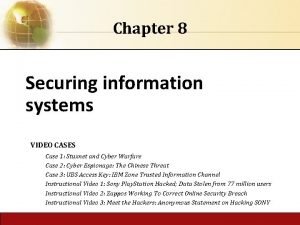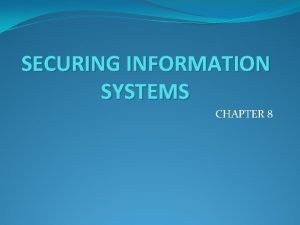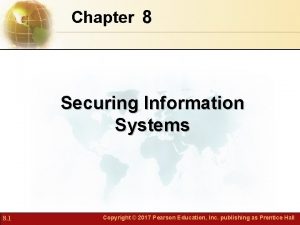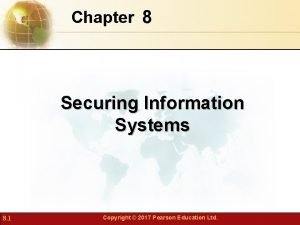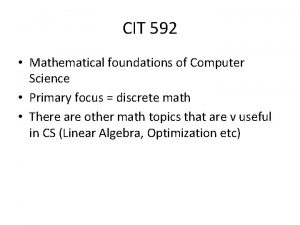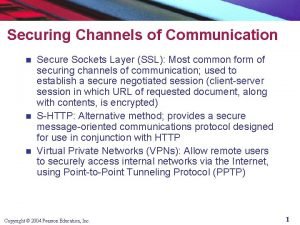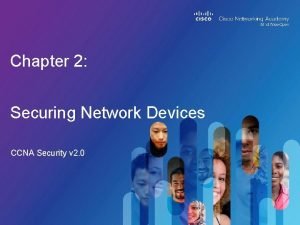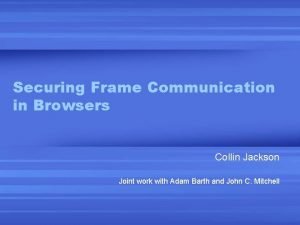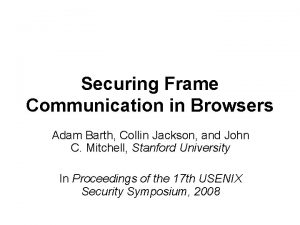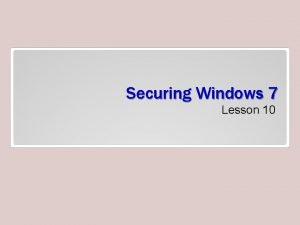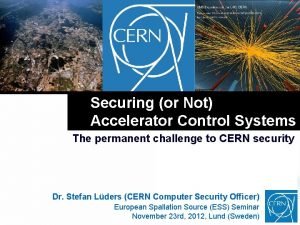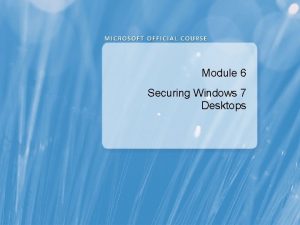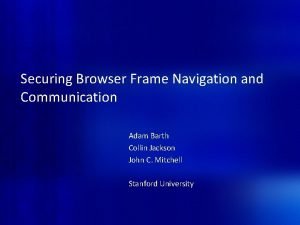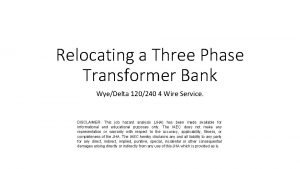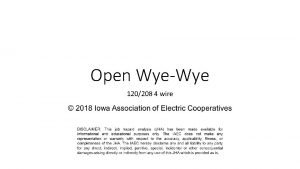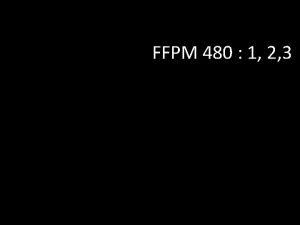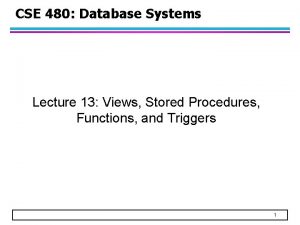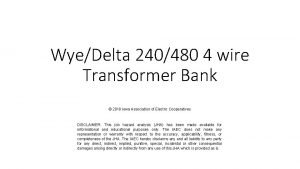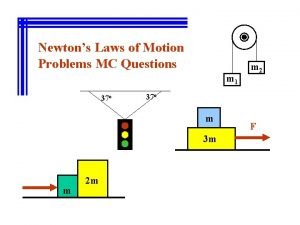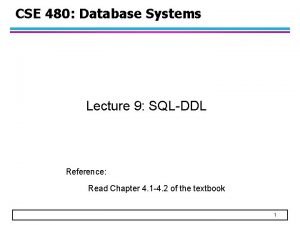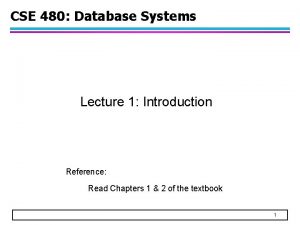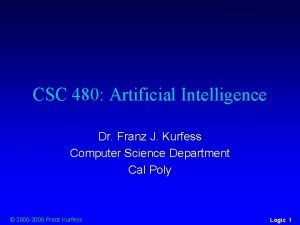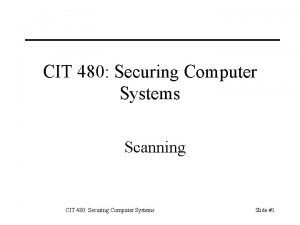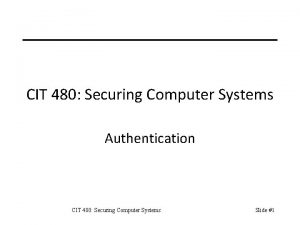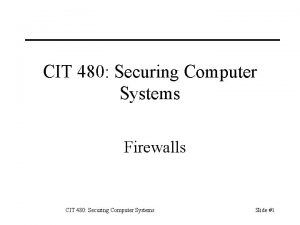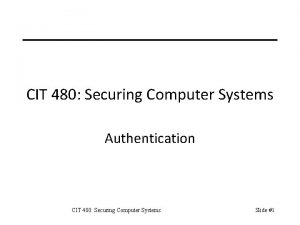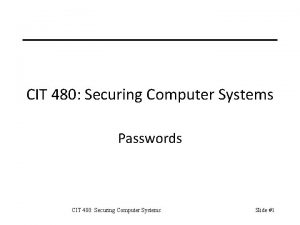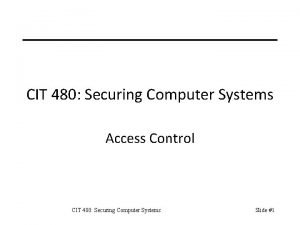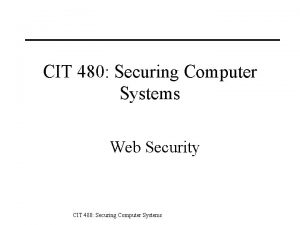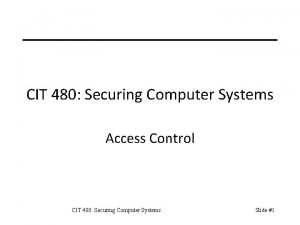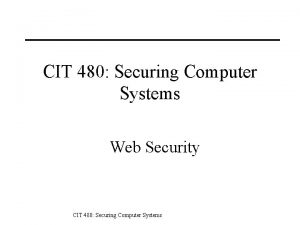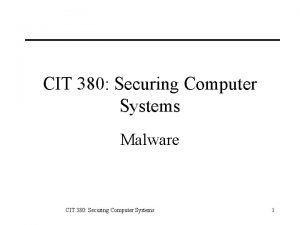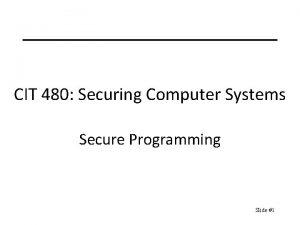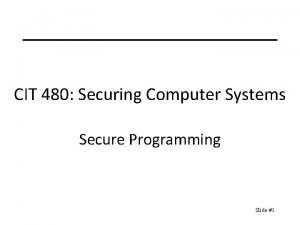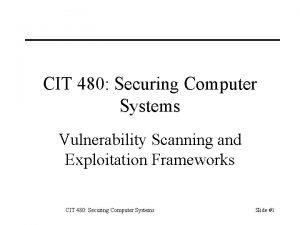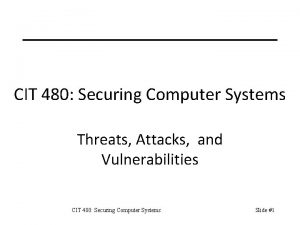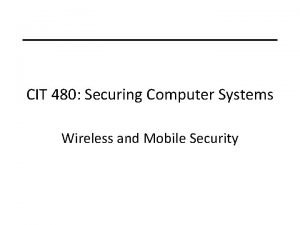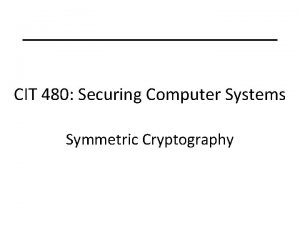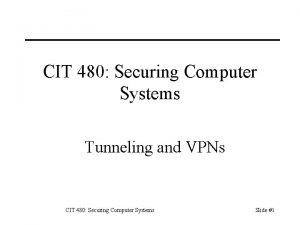CIT 480 Securing Computer Systems Malware Slide 1








































- Slides: 40

CIT 480: Securing Computer Systems Malware Slide #1

Topics 1. 2. 3. 4. 5. 6. 7. 8. Malware Detection Virus Types Infection Methods Rootkits Malware Analysis Protective Mechanisms Malware Factories Botnets Slide #2

Malware, short for malicious software, is software designed to gain access to confidential information, disrupt computer operations, and/or gain access to private computer systems. Malware can be classified by how it infects systems: – Trojan Horses – Viruses – Worms Or by what assets it targets: – – – Ransomware Information stealers Spyware and adware Backdoors Rootkits Botnets Slide #3

How much malware is out there? Slide #4

Static Malware Detection Signature-based – Look for known patterns of bytes in malicious code. – Defeated by polymorphic/metamorphic viruses. Decryption – Brute-forces simple XOR-based encryption. – Checks decrypted text against small virus signature set to decide whether has plaintext or not. Heuristics – Set of signatures that can match in any order, with stretches of metamorphic or legitimate code between. – List of suspicious coding techniques (a type of signature). – Software scored on number of signatures matched, weighted by the importance of each one. Slide #5

Sandboxes Isolated VMs for dynamic malware detection. – Execute potential malware on VM. – Scan VM after a certain amount of time. – Examine memory, filesystem, network. Slide #6

Slide #7

Theory of Malicious Code Theorem 1: It is undecidable whether an arbitrary program contains a computer virus. Proof: Define virus v as TM program that copies v to other parts of the tape, while not overwriting any part of v. Reduce to Halting Problem: T’ running code V’ reproduces V iff running T on V halts. Theorem 2: It is undecidable whether an arbitrary program contains malicious logic. Slide #8

Viruses A computer virus is a type of malware that, when executed, replicates by inserting copies of itself (possibly modified) into other files. This process is called infecting. Slide #9

Types of Viruses 1. Boot Sector – – – When system boots, code in boot sector executed. Propagate by altering boot disk creation. Uncommon today because of low use of boot floppies, but some Vista laptops shipped with one. 2. Executable – – – Infects executable programs (e. g. , COM, EXE). Executes when infected program is run. Virus usually runs first, then runs original code. 3. Dynamic Library – – Infected dynamically linked libraries (DLLs. ) Executed when any program uses infected DLL. Slide #10

Types of Viruses 4. Device Driver – – Infects loadable device driver. Executes in kernel mode. 5. Virtual Machine (. NET) – – Infects. NET MSIL binaries. Portable: compiled to native code by CLR. 6. Archive Infectors – – Inserts Trojan Horse into ZIP files. Uses social engineering techniques to get user to run. Slide #11

Types of Viruses 7. Macro Virus – Infects embedded interpreted code. – Needs interpreter like sh, MS Word macro. – Can infect executables or data files • Executables must invoke appropriate interpreter. – Most modern data formats support some type of scripting, including • Microsoft Office • Windows Help files • HTML: VBScript, JScript Slide #12

Infection Methods 1. Overwriting – – Overwrites section of program file with virus. May break infected program. 2. Companion – – – Infects COM file of same name as EXE file. Given a name, Windows runs COM before EXE Infects alternate data stream of Win 32 file. Legitimate application file. exe Virus: infect() if trigger payload() run file. exe file. com Slide #13

Infection Methods: Prepending 3. Prepending – Insert virus code at beginning of executable. – Shift original code to follow virus. Virus code Executable code Infection Slide #14

Infection Methods: Appending 4. Appending – Append virus code to executable. – Insert JMP at beginning of executable. Jump to Virus Executable code Infection infect() if trigger payload() goto start Slide #15

Infection Methods: Fragmenting 5. Fragmenting – Append virus code to executable. – Insert JMP at beginning of executable. Jump to Virus Executable code Infection Virus code Executable code Virus code Slide #16

Rootkits hide Malware • A rootkit is a type of software used to hide files, processes, network connections. • Much modern malware uses rootkit techniques to hide. • Rootkits can be detected by examining filesystem when OS is not running. • Rootkit detectors can find some rootkits while running by looking for modifications of OS data structures. User Program Rootkit Operating System Slide #17

Malware Handling Process 1. 2. 3. 4. 5. 6. Static Analysis (for signatures) Dynamic Analysis (for signatures) Reverse Engineering (if needed) Signature Creation Quality Assurance Signature Deployment Slide #18

Static Analysis Static analysis includes any approach to analyzing a program without running it. – File type – Strings found in file – Assembly code for program Safest form of analysis, as malware is never executed. Slide #19

Dynamic Analysis Dynamic analysis includes any approach to analyzing a program while running it. – Malware sandbox (to run malware safely). – Host analysis tools (local changes). – Network analysis tools (network traffic). Slide #20

Reverse Engineering Reverse engineering is the use of static analysis (decompilers, disassemblers) and dynamic analysis (debuggers) techniques to determine precisely how a program works. Slide #21

Static Malware Protection 1. Encryption. – Virus starts with small decryption algorithm. – Remainder of virus is encrypted, typically XOR with key. – Often encrypts different parts of virus with different encryption techniques or keys. 2. Polymorphism – Changes encryption key or technique each infection. – Dynamic scan wait til malware decrypts self in RAM. 3. Metamorphism – Rewrites decryption code using different machine instructions each infection too. Slide #22 – Too many variants for signature detection

Dynamic Malware Protection 1. Anti-sandboxing techniques. – Researchers use VMs to analyze malware safely, so – If detect VM, then disable or delete self. 2. Anti-debugging tricks. – Researchers use debuggers to analyze software activity. – Detect some debuggers and break debugging session. – Write code in such a way to make it difficult to debug. 3. Anti-detection techniques. – Disable AV software on system. – Obfuscate code. Slide #23

Malware Factories Malware factories are software and processes to automate the production and protection of malware, allowing threats to produce thousands of different malware from an original program, all of which are well protected.

Malware Factory Process 1. 2. 3. 4. 5. 6. Mutate malware code (metamorphism). Encrypt malware (polymorphism). Pack malware. Bind malware to Trojan cover file. Armor malware (anti-sandbox, debug, detect) Quality assurance Upload to vscan. novirusthanks. org to verify no current AV tool can detect it. Slide #25

Runtime Packers Runtime packers compress the code of programs better than general purpose compression tools and automatically decompress the program upon execution. Today they are primarily used to prevent analysis of programs. – Thousands of packers exist. – Can pack code multiple times with different packers. – AV can unpack some formats, but not all. Slide #26

EXE Binding An EXE binder takes multiple programs and merges them into a single executable file that performs the functions of all of them. It is primarily used to bind malware into legitimate programs to make Trojan horses. Slide #27

Botnets A botnet is • A network of compromised machines • that can be controlled remotely • used for malicious activities. Bot 1 Bot 2 Threat Command & Control Server Bot n Slide #28

Botnets Slide #29

Botnet Components Host Component – Malware running on victim’s computer. – Receives commands from botmaster. – Executes attacks. – Sends data to botmaster. Network Components – Command & Control (C&C) servers. – Malware distribution servers. – Drop zone (for data exfiltration). Slide #30

C&C Structure Centralized – All bots connect to a single C&C server. – Single point of failure that can take down botnet. Decentralized (peer-to-peer) – Every bot is also a C&C server. – Botmaster can administrate from any bot. Hybrid – Every bot is a C&C server. – Also have separate C&C server. Slide #31

Botnet Applications 1. 2. 3. 4. 5. 6. Distributed Denial of Server (DDo. S) Click fraud Spam replay Pay-per-install agent Large-scale information harvesting Information processing Slide #32

Stopping Botnets 1. 2. 3. 4. Identify C&C server(s) and take down. Block C&C server DNS name. Block C&C server IP address. Update anti-virus to identify host component and remove (difficult to reach every infected host. ) 5. Identify botmaster(s) and work with law enforcement to stop them. Slide #33

Protecting C&C 1. Bulletproof Hosting 1. ISP that permits criminal activity, spamming, &c. 2. Dynamic DNS 1. C&C changes IP addresses every few minutes. 2. Uses DDNS service to point to changing IPs. 3. Fast Fluxing 1. DNS requests resolve to set of flux agent IPs. 2. Flux agents redirect traffic to C&C server. Slide #34

Single Flux Networks Slide #35

Double Flux Networks 1. Single flux change DNS name to IP mapping. 2. Double flux change DNS servers for domain too. Slide #36

Domain Generation Algorithms Generate domain names for C&C servers – Algorithmic, but hard to predict. – Generate hundreds to thousands per day. Botmaster knows DGA domains – Sets up C&C at one of the domains. – Waits for bots to contact & request commands. Defends against C&C takedown – Too many domains to blacklist. – Generated domains are expendable, so takedowns don’t matter as botmaster has moved on to new ones. – Botmaster can register C&C domains in future, so they’re not available to takedown on infection. Slide #37

DGA Disadvantages 1. DGA bots produce much network traffic to nonexistent domains, returning errors. 2. If DGA is reverse engineered, someone can take control of botnet by registering domain name of a future C&C server. Slide #38

Key Points 1. Malware Handling Process Static Analysis (for signatures), Dynamic Analysis (for signatures), Reverse Engineering (if needed), Signature Creation, QA, Signature Deployment 2. Rootkit techniques hide malware from running software. 3. Malware Factory Process Mutate malware code (metamorphism), Encrypt malware (polymorphism), Pack malware, Bind malware to Trojan cover file, Armor malware (antisandbox, debug, detect), QA 4. Botnets 1. 2. 3. Host and network components. Command & Control servers are weak point. C&C protection: bulletproof hosting, dynamic DNS, fast flux, DGA 5. Provably impossible to construct perfect AV software. Slide #39

References 1. AV-Test. org, Malware Statistics, http: //www. avtest. org/en/statistics/malware, 2013. 2. Christopher Elisan, Malware, Rootkits, & Botnets: A Beginner’s Guide, Mc-Graw Hill Osborne Media, 2012. 3. William Salusky and Robert Danford, Know Your Enemy: Fast-Flux Service Networks, http: //www. honeynet. org/papers/ff/, 2007. 4. Michael Sikorski and Andrew Honig, Practical Malware Analysis: The Hands-On Guide to Dissecting Malicious Software, No Starch Press, 2012. 5. Ed Skoudis, Counter Hack Reloaded, Prentice Hall, 2006. Slide #40
 480+480
480+480 Autohotkey obfuscator
Autohotkey obfuscator Cit computer systems
Cit computer systems Mcit 593
Mcit 593 Heel and toe polka step
Heel and toe polka step Securing information systems
Securing information systems Securing information systems
Securing information systems Securing information systems
Securing information systems Chapter 8 securing information systems
Chapter 8 securing information systems An information systems examines a firm's overall security
An information systems examines a firm's overall security Chapter 8 securing information systems
Chapter 8 securing information systems Chapter 8 securing information systems
Chapter 8 securing information systems Cit592
Cit592 Securingthehuman
Securingthehuman The most common form of securing channels is through.
The most common form of securing channels is through. Securing network devices
Securing network devices Securing frame communication in browsers
Securing frame communication in browsers Adam secure browser
Adam secure browser Chapter 8 securing the republic summary
Chapter 8 securing the republic summary Securing windows 7
Securing windows 7 Securing
Securing Securing windows 7
Securing windows 7 What is draping in cosmetology
What is draping in cosmetology Securing the northwest territory
Securing the northwest territory Adam secure browser
Adam secure browser 277 480 transformer bank
277 480 transformer bank Wye transformer bank
Wye transformer bank 277/480 transformer bank
277/480 transformer bank Mamy ny foko
Mamy ny foko Cse 480
Cse 480 240/480 transformer bank
240/480 transformer bank William morris wallpaper - hyacinth, pattern #480
William morris wallpaper - hyacinth, pattern #480 A person of weight 480 n stands
A person of weight 480 n stands Mk 480
Mk 480 Schafer pens
Schafer pens Ece 480
Ece 480 Cse 480
Cse 480 Cse 480
Cse 480 Csc 480 degrees
Csc 480 degrees Scratch
Scratch 480-323 bce
480-323 bce


